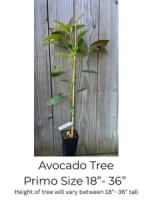- Pinkerton Avocados have rich and creamy texture with an irresistible nutty flavor.
- The Pinkerton Avocado tree is a heavy, early producer near coast and inland.
- The fruit is green, with medium pebbly skin.
- Fruit size is about 14-16 oz.
- The Pinkerton Avocado tree is a medium spreading tree
- Ripens February-June
- Height at maturity: 20'-30'/ 15' wide
- Grafted onto Mexican Seedling rootstock
- Suitable for USDA Zones 9-11
- Mature trees should be protected when temperatures fall below 28 F
- Trees younger than 3 years should be protected from temperatures below 32 F
-
A TYPE. Requires a TYPE B nearby for pollination in most climates.
Click here to see our Avocado Tree Variety Chart
SAVE ON SHIPPING: We can now ship potted fruit trees in MULTIPACK BOXES. Order as a 3-pack or 6-pack to save on the cost of shipping! This includes ALL PRIMO and ENTRY sized citrus, olive, fig, avocado trees and passion vines.
Check out ourAvocado Tree Growing Guide (pdf)
Lee nuestra guia:Guia de cultivo para aguacate









